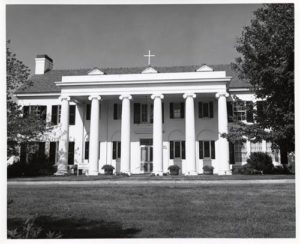
Rixey Mansion, now part of Marymount University, stands on the site of Mary Ann Hall’s country house.
Mary Ann Hall, sister of Bazil Hall, the farmer and slave owner for which Hall’s Hill (now Highview Park) was named, also owned property in Arlington which she used as a summer home and country house. The main building of Marymount University, Rixey Mansion, now occupies the site of Mary Ann’s farmhouse.
Mary Ann was a high-class madam in Washington where she ran a brothel (located at the foot of Capitol Hill) for over 40 years. She bought the lot and had the brothel built to her specifications, a substantial house with four stories containing 25 rooms and a basement.
When the construction for the National Museum of the American Indian began, professional archeologists were called in to interpret the site where her house stood. The results of the excavation showed that the quality of materials at the site was better than that of the surrounding neighborhood. Tableware was expensive and seeds and bones found showed a nutritional diet that included substantial amounts of beef, poultry and fish as well as turtle, and fruits such as coconuts and berries. Also found were dozens of corks and bottles which seemed to indicate Mary Ann’s fondness for champagne.
A successful business woman, in 1853 she was able to purchase a farm in Alexandria County (now Arlington) to which she gradually added through 1869. As she grew older she spent more time at the farm and turned over business matters to her younger sister Elizabeth.
District of Columbia court records show that when she died, Mary Ann Hall was worth $87,000 (about $2,000,000 today) with no debts. A list of her belongings included Belgian carpets, oil paintings, plush red furniture and an ice box as well as a large number of sheets, mattresses, blankets, feather pillows and comforters.
Mary Ann never married, had children or kept a diary. She left no collection of personal letters or business ledgers, so there is little known about her as an individual. However, her obituary in the Evening Star described her as a person of unquestioned integrity and a heart open to “appeals of distress and a charity that was boundless.”
After her death in 1886, she was buried in Congressional Cemetery. The inscription on her grave monument reads:
Truth was her motto
Her creed charity for all
Dawn is coming.
 Of the two Shreve family cemeteries in Arlington, the Southern-Shreve cemetery could possibly lay claim to having a more unique history. Located on the north side of Fairfax Drive, between North Frederick and North Harrison streets, the cemetery sat near the property of Richard and Frances (Redin) Southern. Richard Southern was a landscape architect and horticulturist, who became known for pioneering the use of the tomato as a food. It may seem hard to believe in these modern times, but prior to Southern’s efforts, the tomato was widely regarded as being poisonous and was only used for decorative purposes.
Of the two Shreve family cemeteries in Arlington, the Southern-Shreve cemetery could possibly lay claim to having a more unique history. Located on the north side of Fairfax Drive, between North Frederick and North Harrison streets, the cemetery sat near the property of Richard and Frances (Redin) Southern. Richard Southern was a landscape architect and horticulturist, who became known for pioneering the use of the tomato as a food. It may seem hard to believe in these modern times, but prior to Southern’s efforts, the tomato was widely regarded as being poisonous and was only used for decorative purposes. Progressive rock… I’m sure that some of you still have a few King Crimson, Yes, Moody Blues, or Emerson, Lake, & Palmer albums lurking in your collections somewhere. While never approaching the popularity of the aforementioned groups, Arlington’s very own entry into the progressive rock sound of the 70’s, The Seventh Dawn, had a story arguably as unique as any, and a sound that avoided the pitfall of many of their superstar contemporaries, which has led to a modest, but well deserved reappraisal of the band that few could have predicted.
Progressive rock… I’m sure that some of you still have a few King Crimson, Yes, Moody Blues, or Emerson, Lake, & Palmer albums lurking in your collections somewhere. While never approaching the popularity of the aforementioned groups, Arlington’s very own entry into the progressive rock sound of the 70’s, The Seventh Dawn, had a story arguably as unique as any, and a sound that avoided the pitfall of many of their superstar contemporaries, which has led to a modest, but well deserved reappraisal of the band that few could have predicted.





